
1. definition of prehistoric period
1.1. Prehistory is the period that begins with the appearance of the human being.
2. stone age
2.1. Mesolithic - neolithic
2.1.1. The Paleolithic was everywhere followed by the Mesolithic, a period when man continued to use stone tools, mostly microlithic, and, while still in the hunting-and-gathering stage, depended less for his food supply on large mammals than on fish and mollusks. In Africa the evidence for the Mesolithic is still scanty.
2.1.1.1. Mesolithic tools : Scrapers were used for cleaning animal skins in the process of making leather. Burins were used for carving or engraving wood and bone, like a chisel. Blades were used as knives and microlights were tiny flints that were glued/fixed to wooden shafts to make arrows or spears for hunting.
2.1.1.2. neolithic tools : Scrapers. Scrapers are one of the original stone tools, found everywhere where people settled, long before the Neolithic Age began Blades Arrows and Spearheads Axes Adzes Hammers and Chisels
3. metal age
3.1. iron age
3.1.1. Iron in Africa. Africa is rather large, and the smelting of iron took place there for at least 2500 years. "Iron in Africa" is thus not a topic that can be covered with some breadth and depth in just a few pages.

